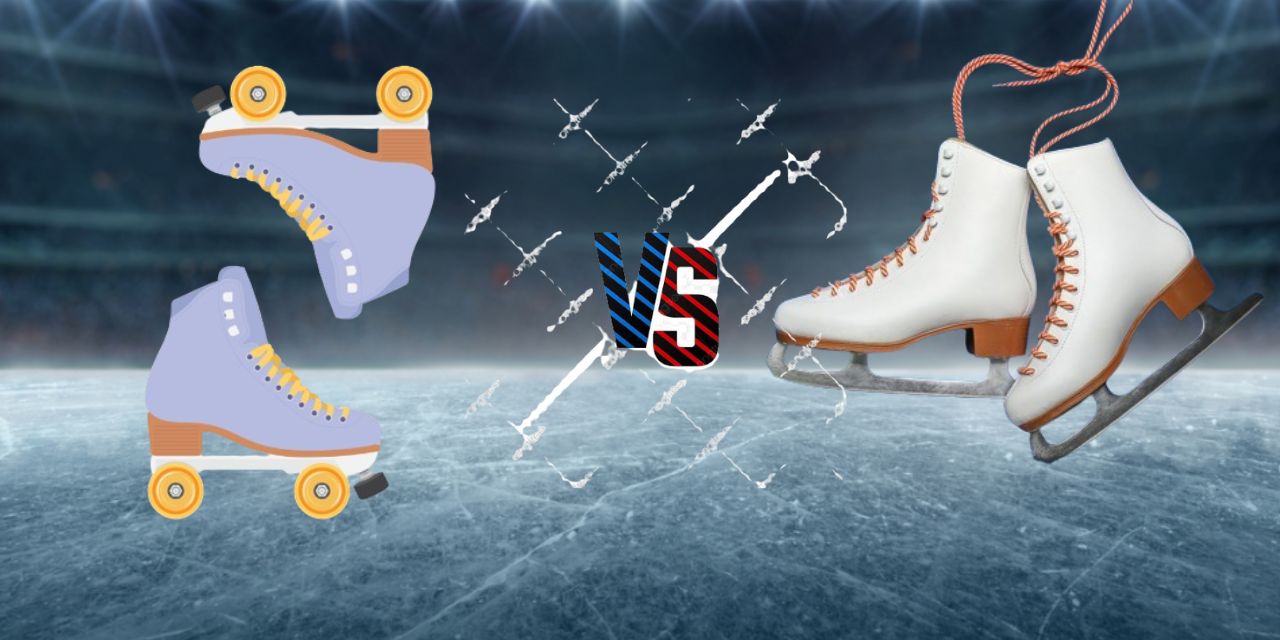Table of Contents
Introduction
Despite their differences in terrain and equipment, ice and roller skating share fundamental similarities that often prompt comparisons. Both activities offer exhilarating experiences while gliding on various surfaces, each possessing unique characteristics and techniques.
Understanding the nuanced distinctions and resemblances between these two popular forms of skating unveils an intriguing exploration into the worlds of balance, agility, and movement.
Dynamics of Surface and Movement
The primary difference between ice skating and roller skating lies in the surface. Ice skating involves gliding across frozen water, necessitating specific blade structures, while roller skating transpires on solid ground, utilizing wheels. Ice skates have a thin metal blade that enables smooth navigation over the icy surface. This necessitates a distinct technique, emphasizing balance and subtle movements to maintain traction and control.
On the contrary, roller skates are equipped with wheels, allowing movement on varied terrains, such as concrete, wood, or other smooth surfaces. The wheels grant a different sensation of movement and require adaptability in steering and maneuvering.
Equipment Variances
Ice skates and roller skates are tailored to suit their respective terrains. Ice skates consist of a boot and a blade for gliding on ice. The blades have edges for stability and control, allowing skaters to perform intricate moves and turns.
In contrast, roller skates typically have four wheels set in pairs, either inline or side-by-side. Each type of roller skate offers diverse functionalities and maneuverability, requiring different techniques to attain balance and precision in movement. Furthermore, roller skates have brakes, unlike ice skates, aiding in halting or slowing down when necessary.
Techniques and Movements
The distinct surfaces and equipment of ice and roller skates result in variations in skating techniques. Ice skating emphasizes glide and edge control. Skaters execute specific movements like crossovers, turns, and spins, relying on the blade’s edges for traction and maneuverability.
On the other hand, roller skating encompasses various styles, such as art, speed, and roller derby, each demanding different techniques. Roller skaters perform crossovers, transitions, and jumps, utilizing the wheels’ dynamics for agility and speed. The techniques for both forms of skating may differ, yet the fundamental principles of balance, coordination, and rhythm remain consistent.
Similarities in Balance and Coordination
Despite the surface disparities, ice and roller skating share a fundamental requirement: balance and coordination. Skaters in both domains need to maintain equilibrium and precise movements.
The core muscles play a pivotal role in stabilizing the body while executing turns, jumps, or spins. Furthermore, coordination between the upper and lower body is crucial for fluid motion and executing complex ice and roller skating routines.
Safety Measures and Protective Gear
Safety is a paramount concern in both ice and roller skating. Regardless of the terrain, protective gear such as helmets, knee pads, elbow pads, and wrist guards are crucial to prevent injuries.
Ice skaters often wear padded clothing and safety gear to protect against cold temperatures. In contrast, roller skaters primarily focus on protective equipment due to the risk of falls on hard surfaces.
Versatility in Styles and Disciplines
Ice and roller skating offers many styles and disciplines that cater to diverse interests and preferences. Figure skating, ice hockey, and speed skating are prominent in ice skating, each with its unique techniques and competitive aspects.
Similarly, roller skating encompasses artistic, speed, and roller derby disciplines, each having its dedicated following and specific skill sets. The versatility in styles allows skaters to explore various forms of expression and competition, expanding the horizons of ice and roller skating enthusiasts.
Differences in Environmental Factors
The environmental factors surrounding ice and roller skating contribute significantly to the overall experience. Ice skating usually occurs in cold, controlled environments, such as indoor or outdoor rinks, with the necessity of frozen surfaces.
Roller skating, however, can transpire in a broader range of settings, including indoor roller rinks, parks, or streets, without the limitations of temperature constraints. The environmental variance plays a substantial role in determining the accessibility and overall enjoyment of these activities.
Benefits and Physical Fitness
Both ice skating and roller skating offer exceptional physical fitness benefits. They serve as engaging cardiovascular exercises that improve heart health, endurance, and overall strength.
Skating involves various muscle groups, enhancing leg strength, core stability, and balance. Additionally, it promotes flexibility and coordination, contributing to overall physical well-being.
Final Words
While ice and roller skating share foundational principles of movement and balance, their distinctions in surfaces, equipment, techniques, and environmental factors make them unique experiences.
Each form of skating offers diverse styles and disciplines, ensuring a rich tapestry of enjoyment and physical activity for enthusiasts. Whether gliding gracefully on ice or maneuvering swiftly on wheels, ice skating, and roller skating deliver exhilarating and fulfilling experiences, each with distinctive charm and challenges.
Frequently Asked Questions
Is ice skating easy if you can rollerblade?
Both excellent and terrible roller skating techniques may be applied to ice skating. Beginner ice skaters will have an easier time navigating the rink if they have previous experience on roller skates. Since the requisite abilities are comparable, ice skating may be learned quickly.
Is roller skating good for girls?
Roller skating is a fantastic exercise that may help you lose weight, build muscle, and feel healthier overall. It’s a great way to tone your legs, glutes, and abs, burn 600 calories an hour, and reduce joint stress by half compared to jogging. The benefits extend to an increase in mobility and stamina.
Is ice skating a sport or not?
In figure skating, individuals, couples, or groups compete on figure skates on ice. When it was originally competed at the Olympic Games in 1908 in London, it made history as the first winter sport to be featured.
Why do people like ice skating?
Ice skating is an efficient kind of aerobic exercise. Skating at a quick speed is an excellent way to exercise the heart and lungs, much like jogging or cycling. Ice skating is great for balance and coordination, even when done slowly. The gliding action also improves joint mobility.
